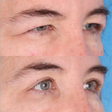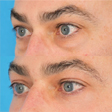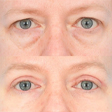Fat Grafting
Conveniently located to serve the areas of Chicago, IL

Fat grafting to the face and eyelids is a procedure that helps enhance facial appearance by transferring fat from one area of the body to facial regions.
Facial volume loss can have several causes, one of the most common being the natural aging process. While facial fillers can help combat volume loss, their effects are temporary or come with the risk of allergic reactions. If you are seeking an effective, more natural method to achieve long-lasting volume restoration in areas of your face and/or your eyelids, you could be an ideal candidate for fat grafting procedures.
When it comes to procedures that restore facial volume, it is vital to seek care from someone who specializes in this area. Dr. Paul Phelps and his team at Chicago Oculofacial Plastic Surgery are the best Illinois has to offer when it comes to facial rejuvenation. They offer several innovative and effective treatments to revitalize your facial aesthetic, including fat grafting to the face.
Anyone looking to revitalize their upper eyelid aesthetic should schedule a personal consultation with Dr. Phelps and the Chicago Oculofacial Plastic Surgery team by filling out the online form or by calling (312) 888-5754.
Contents
Before and After Photos
About Fat Grafting to Eyelids and Face
Fat grafting to the face and eyelids can help you enhance your facial appearance by transferring your own fat from one part of your body to these areas. This technique is also known as autologous fat grafting. The fat is taken from areas with excess fat, such as the abdomen or thighs, and then it is injected into areas of the face that could benefit from volume restoration. The harvested fat can be redistributed to the eyelids as well as other areas, such as the cheeks or temples.
People seek fat grafting to the face and eyelids for various reasons. Many want to rejuvenate their appearance as they age, while others may wish to correct facial asymmetries or enhance certain features for aesthetic purposes. Fat grafting is highly regarded for its ability to restore facial volume using the patient’s own fat, rather than synthetic materials, which significantly reduces the risk of adverse reactions. (2)
Benefits
There are numerous benefits associated with fat grafting procedures, particularly for restoring facial volume in areas such as the eyelids. Key advantages include:
- Natural Results: Since the procedure uses your own fat, there is minimal risk of rejection, leading to natural-looking enhancements.
- Improved Volume Restoration: Fat grafting effectively restores lost volume in specific areas to produce revitalized facial contours.
- Long-Lasting Effects: Compared to dermal fillers, which require repeat treatments, fat grafting often yields results that last for years.
- Enhanced Skin Texture: The fat introduced during the procedure improves skin quality, contributing to smoother and healthier skin.
- Minimally Invasive Procedure: The surgery requires only small incisions, which minimizes scarring and allows for quicker healing compared to traditional surgical options.
- Decreased Risk of Adverse Reactions: Using your own fat means there is no risk of allergic reactions or complications arising from synthetic materials. (2)
- Dual Benefit: Patients benefit from both contour enhancement and liposuction, as excess fat is removed from unwanted areas during the harvest phase.
- Versatility: The same fat grafting technique can address multiple areas on the face simultaneously, providing comprehensive rejuvenation.
If you are interested in learning how you can benefit from fat grafting procedures, schedule a personal consultation with Dr. Phelps and the Chicago Oculofacial Plastic Surgery team by contacting us online or by calling (312) 888-5754.
Ideal Candidates
Several factors will determine whether or not someone is an ideal candidate for facial fat grafting procedures, as some patients may benefit more from different treatment methods. Facial fat grafting does, however, appeal to a wide range of potential candidates. Patients who seek facial fat grafting tend to be individuals who are experiencing:
- Loss of volume in the cheeks or temples
- Hollow areas underneath the eyes
- Prominent nasolabial folds
- Dark circles around the eyes
- Wrinkles around the mouth
Whether or not you are an ideal candidate for facial fat grafting will be established during your personal consultation with Dr. Phelps, as he will perform a thorough assessment to recommend the best methods to help you achieve your desired outcomes.
Personal Consultation
Scheduling a personal consultation with Dr. Phelps at Chicago Oculofacial Plastic Surgery is the vital first step to understanding whether fat grafting is right for you. During this meeting, Dr. Phelps will review your medical history, assess your facial structure, and attempt to get to know you as well as what you hope to achieve with facial rejuvenation. Once he has done this, he will work to create a personalized treatment plan tailored specifically to help you reach your aesthetic goals.
To get started on your journey toward revitalized eyelids and an overall more youthful facial aesthetic, schedule a personal consultation with Dr. Phelps and the Chicago Oculofacial Plastic Surgery staff by contacting us online or giving us a call at (312) 888-5754.
Preparation
Preparing for your fat grafting procedure is key to a smooth experience and optimal results. Dr. Phelps and his team will provide you with detailed preoperative instructions, which may include guidelines on discontinuing blood-thinning medications and supplements. Additionally, it is important to cease smoking well ahead of your surgery, as nicotine can interfere with the healing process. Arranging time off from work and social commitments is recommended so you can rest and recover comfortably after the procedure. Since anesthesia is involved, you should plan a ride home and make accommodations for assistance during the initial recovery phase.
Procedure
Fat grafting procedures are tailored specifically to your needs. After administering anesthesia to ensure your comfort (likely local anesthesia with sedation or general anesthesia), Dr. Phelps carefully harvests fat from a donor area–commonly the abdomen or thighs. This harvested fat is then purified before Dr. Phelps reinjects it into targeted areas of the face and/or eyelids. The procedure is highly individualized, and the exact method may vary depending on your unique facial anatomy and desired outcome.
Recovery
Recovery from a fat grafting procedure is a gradual process that varies from patient to patient. Mild swelling and bruising around the treated areas are common and usually diminish within a few weeks. To help reduce swelling, you may be advised to use cold compresses and keep your head elevated during the initial period. Most patients find that they can resume normal activities within one to two weeks, though more strenuous activities should be avoided until you receive clearance from Dr. Phelps. Your progress will be carefully monitored during follow-up visits to ensure a smooth and steady recovery.
Results
Once the recovery phase is complete, many patients enjoy a noticeable enhancement in facial volume and a refreshed, more youthful appearance. It is important to remember that while some improvements are visible soon after the procedure, the full effects develop gradually as swelling subsides and the fat integrates with the surrounding tissue. Dr. Phelps employs advanced techniques that consistently make for exceptional results.
Corresponding Procedures
Fat grafting treatments to the eyelids or other areas of the face can be combined with other cosmetic procedures to achieve comprehensive results. While numerous treatments can be combined with facial fat grafting, some might include CO2 laser resurfacing or IV therapy.
Cost of Fat Grafting in Chicago

The cost of your fat grafting procedure will be determined by several factors, and a detailed cost estimate will be given to you during your personal consultation. Generally speaking, facial fat grafting procedures tend to cost between $4,500 to $8,000. For more information, check out Chicago Oculofacial Plastic Surgery’s pricing page.
To get a more accurate estimate for your unique procedure, schedule your consultation online or give us a call at (312) 888-5754.
FAQ
Can I return to work the next day after facial fat grafting?
Most patients require approximately one to two weeks before returning to their normal activities. However, this can vary based on individual recovery rates and the physical demands of one’s job.
How long do the results of facial fat grafting last?
While some fat may be reabsorbed by the body, the results of fat grafting tend to be essentially permanent.
Are there risks involved in fat grafting?
As with any surgical procedure, there are potential risks, such as infection or irregularities in texture. Discussing these risks with Dr. Phelps during your consultation will provide clarity.
Does fat grafting take a long time to heal?
Swelling will subside gradually over a few weeks. Most individuals are fully healed within three months, with varying durations between individuals.
Are there any alternatives to fat grafting?
Yes, there are alternative treatments to fat grafting, such as dermal fillers, that can be used to improve volume loss and enhance appearance.
References
- Vasavada A, Raggio BS. Autologous Fat Grafting For Facial Rejuvenation. PubMed. Published 2021. https://www.ncbi.nlm.nih.gov/books/NBK557860/
- Brucato D, Ülgür II, Alberti A, Weinzierl A, Harder Y. Complications Associated with Facial Autologous Fat Grafting for Aesthetic Purposes: A Systematic Review of the Literature. Plastic & Reconstructive Surgery Global Open. 2024;12(1):e5538-e5538. doi:https://doi.org/10.1097/gox.0000000000005538






